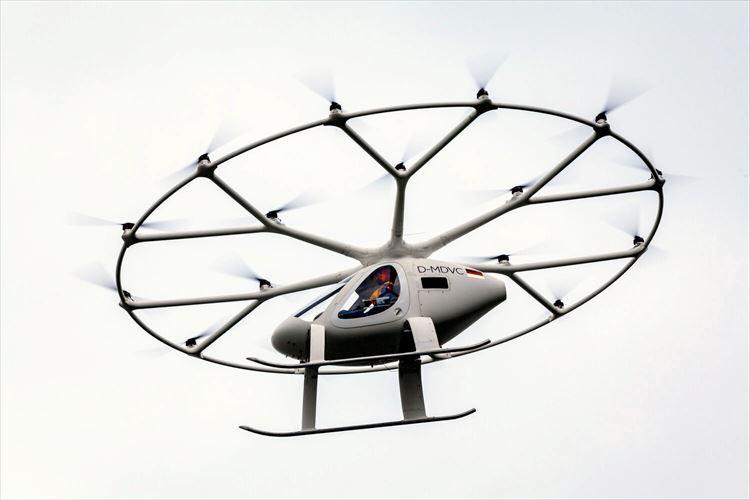When will the "flying taxi" be put...
05
11
When will the "flying taxi" be put to practical use? World competition for development, 2025 Osaka Expo will be a turning point
■Leading German venture
In October 2019, an eVTOL crossed in front of a high-rise hotel in Singapore's leading resort Marina Bay Sands. A circular frame like a crown is on top of the egg-shaped fuselage. It has 18 propellers. The small propeller somehow reminds me of Takecopter, Doraemon's secret gadget. It was a test flight for commercialization.
The maximum speed is 110 kilometers per hour, but it is much quieter than a helicopter with a large propeller, and it is expected to be able to take off and land without worrying about noise even in big cities.
It was created by German venture company Volocopter. "In Singapore, we want to commercialize 'air taxis' within two to three years. We are taking on an unprecedented challenge." Hong Rungchu, 33, who is in charge of operations in Southeast Asia, puts a lot of effort into it.
Founded in 2011, the company is a pioneer in eVTOL. In 2016, it obtained permission for manned flights from the German authorities and successfully completed its maiden flight. "It's not easy to build an aircraft that meets safety standards, but we've built trust by working with authorities," Hong said. Japan is also aiming for a manned flight at the Osaka Expo in 2025.
In Singapore, the policy is to commercialize it in the form of a sightseeing flight, but it is said that international traffic is also being considered in the future.

The company doesn't specify where it's targeting, but for example, the two roads that connect the island nation of Singapore to neighboring Malaysia are both heavily trafficked and notoriously congested. The strait separating the two countries is about one kilometer wide. If it becomes possible to travel back and forth using the sky, convenience will be greatly improved, and it is likely that the form of movement will change greatly.
■Climate change and traffic congestion countermeasures, growing attention
The new means of air transportation in urban areas is also called "Urban Air Mobility" (UAM). This is a field that has grown rapidly in the last five years.
In 2019, KPMG, a major consulting firm, issued a report stating that the number of UAM users was about 12 million a year in the 1930s and will exceed 400 million by 2050.
Among them, the attention to eVTOL is high. Again, climate change is in the background. Because it's electric, it doesn't emit greenhouse gases when it flies. Although a large amount of energy is required for takeoff and ascent, the advantage of being able to move efficiently in a straight line between the starting point and the destination and avoiding road congestion is great.
More and more companies entered the market.
"From Narita Airport to Tokyo Station in about 14 minutes". British venture Vertical Aerospace is planning to do business in Japan with such a high-speed eVTOL as its selling point. In September, the company announced a partnership with major trading company Marubeni and embarked on market research in Japan. It aims to obtain safety certification from European authorities in 2024.
China's EHANG, founded in 2014, has been conducting test flights around the world, and in June this year, it succeeded in the first outdoor test flight in Japan in Okayama Prefecture.
Amid intensifying development competition around the world, Sky Drive (headquartered in Tokyo), which was founded in 2018, originated in Japan. In August of last year, it successfully completed its first manned test flight, albeit indoors. On October 29, 2018, the Ministry of Land, Infrastructure, Transport and Tourism accepted the application for the safety certification. This is the first application for eVTOL safety certification. The goal is to commercialize it in Osaka in 2025.
Because it is electrically controlled, there is also an expectation that unmanned operation will be realized. However, there are many challenges. Technically, it is a response to sudden environmental changes such as sudden changes in weather and contact with birds. It will also be necessary to create regulations regarding route management and responsibility in the event of an accident.
Even in Japan, the discussion on the issue progresses little by little. In 2018, the Ministry of Land, Infrastructure, Transport and Tourism and the Ministry of Economy, Trade and Industry established the Public-Private Council for the Air Mobility Revolution. The number of private company members increased to 29. An official of the Ministry of Land, Infrastructure, Transport and Tourism said, "Expo '70 Osaka will be a milestone for commercialization."


![[Kill personally developed games] Top class in app history! Too beautiful water puzzle "a [Q] ua" | Famitsu App for smartphone game information [Kill personally developed games] Top class in app history! Too beautiful water puzzle "a [Q] ua" | Famitsu App for smartphone game information](https://website-google-hk.oss-cn-hongkong.aliyuncs.com/drawing/article_results_7/2022/3/3/66755df992ff2d2b1e1ab43844ef9f88_0.jpeg)





![[Latest in 2021] 10 recommended seat covers for cars!If you want to improve the texture and functionality of the car, choose the mounting type and material. [Latest in 2021] 10 recommended seat covers for cars!If you want to improve the texture and functionality of the car, choose the mounting type and material.](https://website-google-hk.oss-cn-hongkong.aliyuncs.com/drawing/article_results_7/2022/3/3/e5b44589e77141f3a633189165fb6f60_0.jpeg)